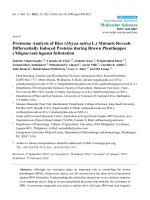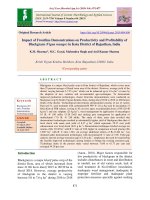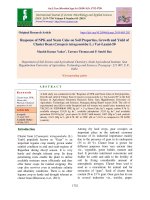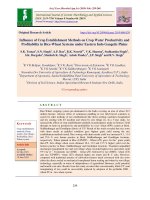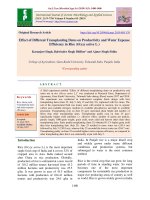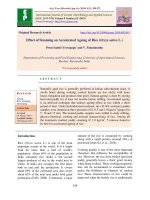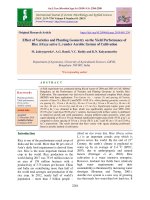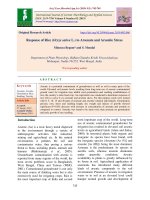Response of plant nutrients on soil fertility, productivity and profitability of rice (Oryza sativa) - Chickpea (Cicer arietinum) cropping system in chhattisgarh plains
Bạn đang xem bản rút gọn của tài liệu. Xem và tải ngay bản đầy đủ của tài liệu tại đây (277.55 KB, 9 trang )
Int.J.Curr.Microbiol.App.Sci (2017) 6(4): 1867-1875
International Journal of Current Microbiology and Applied Sciences
ISSN: 2319-7706 Volume 6 Number 4 (2017) pp. 1867-1875
Journal homepage:
Original Research Article
/>
Response of Plant Nutrients on Soil Fertility, Productivity and
Profitability of Rice (Oryza sativa) -Chickpea (Cicer arietinum)
Cropping System in Chhattisgarh Plains
C.K. Chandrakar1*, M.C. Bhambri2, G.P. Pali2, Sunil Kumar2, A. Jangde1,
K.K. Pandey1 and Sanjeev Singh3
1
S. K. College of Agriculture and Research Station, Kawardha Kabirdham (C.G.), India
2
College of Agriculture, IGKV, Raipur (C.G.), India
3
AICRP-IFS project at OFR centre, S.K.C.A.R.S., Kawardha, Kabirdham (C.G.), India
*Corresponding author
ABSTRACT
Keywords
Rice-chickpea
cropping system,
Nutrient response,
Productivity, Soil
fertility, Economics.
Article Info
Accepted:
15 March 2017
Available Online:
10 April 2017
A field experiment was conducted to study the on farm crop response to plant nutrients in
pre dominant cropping system i.e. rice, (Oryza sativa) - chickpea (Cicer arietinum) and
their impact on productivity, soil fertility and economics at Kabirdham district of
Chhattisgarh state during 2013-14 and 2014-15. The results revealed that application of
100 kg N, 60 kg P2O5, 40 kg K2O and 20 kg ZnSO4 /ha to rice and 20 kg N, 50 kg P2O5, 20
kg K2O /ha to chickpea recorded significantly higher grain and straw/ haulm yields. Rice
equivalent yield (87.72 q/ha), net returns (Rs 74,391), benefit cost ratio (2.74) and total
NPK uptake by rice-chickpea cropping system (409.89 kg/ha) were recorded over rest of
the treatments. This treatment also recorded the maximum production efficiency (39.87 kg/
ha/day). Response studies indicated that maximum response was noted with NPK in Rice
(15.9 kg/kg) and N in chickpea (15.8 kg/kg).
Introduction
Rice-chickpea cropping sequence is one of
the predominant cereals-legume cropping
systems being followed in Chhattisgarh as
well as in India and occupies considerable
geographical distribution. Chhattisgarh plain
zone has been blessed with vast tract of area
where in farmers are often growing rice and
chickpea in sequence. Rice crop is popular in
Chhattisgarh
due
to
its
versatile
characteristics of suitability and adaptability
with good market price. Chickpea is preferred
after harvest of rice as the crop is the
paramount
source
of
protein
in
predominant1y vegetarian diet. Besides this,
crop supplies nutritious fodder, feed and it
specially fortifies soil through biological
nitrogen fixation which is economically sound
and environmentally acceptable thereby
sustaining the productivity of the cropping
system.
The productivity of rice and chickpea of
Chhattisgarh are lower than national
productivity might be due to low and
imbalanced applications of nutrients by the
farmers of Chhattisgarh. The continuous use
of under and less amount of nutrients to soil
erodes the nutrient base and affects the
1867
Int.J.Curr.Microbiol.App.Sci (2017) 6(4): 1867-1875
productivity (Gangawar et al., 2014). In the
recent years, deficiency of micronutrient
particularly Zn, is also a factor for decline in
the productivity of the system (Hiremath et
al., 2015).
Intensive cultivation and growing exhaustive
crops have made the soil deficient in macro as
well as in micronutrients. The success of any
cropping system depends upon the
appropriate management of resources
including balanced use of manures and
fertilizers. The cultivation of legumes has
made radical improvement in the farming
community (Vidyavathi et al., 2011). Among
the various agro-techniques, fertilizer is the
single most important input in modern
agriculture to raise the crop productivity. To
get maximum returns, fertilizers must be
applied in a well balanced ratio, leading to
their efficient utilization. Though information
on nutrient management in individual crops is
abundantly available, but the system-based
information is meager. Moreover, single
nutrient approach has been replaced by multinutrient so as to boost up crop productivity
and nutrient use efficiency. Besides, nutrient
management in cropping system is more
efficient and judicious than individual crop, as
succeeding crops take care of the residual
effect of nutrients. The present experiment
was, therefore, undertaken to study the “On
farm crop response to plant nutrients in terms
of productivity, soil fertility, nutrient uptake,
production efficiency as well as net monetary
returns of rice (Oryza sativa)-chickpea (Cicer
arietinum) cropping system
Materials and Methods
Field experiments were conducted during
kharif and rabi seasons of 2013-14 and 201415 on farmers’ fields in Khandsara, Heerapur
and Chorbhhatti villages of Kawardha block
and Chilamkhodra, Saliha and Shingarpur
village of Sahaspur Lohara block of
Kabirdham district in plain zone of
Chhattisgarh. The physical and chemical
characteristics of soils for all the sites are
given in table 1.
The experiment comprised of seven
treatments viz. control, N, NP, NK, NPK,
NPK+ZnSO4 and farmers' practice was
applied to rice and chickpea cropping system.
The experiment was conducted in randomized
block design with 24 replications. Rice
cultivar MTU 1010 and chickpea cultivar
Vaibhav were grown. The recommended dose
of N:P2O5:K2O:ZnSO4 : 100:60:40:20 kg/ha
and 20:50:20:0 kg/ha for rice and chickpea
respectively was applied. Whereas, in
farmer’s practices 50:30:20:0 kg/ha and
18:48:0:0 kg/ha N: P2O5: K2O: ZnSO4 were
applied in rice and chickpea crops
respectively. Half of the nitrogen and full
doses of P and K were applied at the time of
transplanting of rice and remaining N was
applied after 30 DAT. Entire fertilizer was
applied at the time of sowing as a basal dose
in chickpea. Nitrogen, phosphorus and
potassium were applied through Urea, Single
super phosphate and Muriate of potash,
respectively. Besides, both crops were raised
with recommended package of practices.
Both the crops were evaluated in terms of
total system productivity, net returns and
benefit: cost ratio. On system basis, chickpea
seed yield was converted into rice grain
equivalent yield (REY) taking into account
the prices of both the crops during the
respective years.
The data of both the years were pooled and
analyzed as per standard procedure. The plant
samples were analyzed for N, P and K
concentration in grain and straw and total N,
P and K uptake was calculated by multiplying
the respective nutrient concentrations with the
yield. Production efficiency (kg/ha/ day) was
calculated by dividing the in rice - grain
1868
Int.J.Curr.Microbiol.App.Sci (2017) 6(4): 1867-1875
equivalent yield with total duration of the
cropping system. Response of rice and
chickpea to N, P and K was calculated by
using the following formulae (Gangwar et al.,
2014):
Where,
Yn=Grain yield under N treated plot (kg/ha)
Ycont=Grain yield under control (kg/ha)
N=Amount of nitrogen applied (kg/ha)
Where,
YNPK=Grain yield under NPK treated plot
(kg/ ha)
YNK=Grain yield under NK treated plot (kg/
ha)
YNP= Grain yield under NP treated plot
(kg/ha)
P=Amount of phosphorus applied (kg/ha)
Where,
K=Amount of potassium applied (kg/ha).
Correlation Coefficient has been calculated
for the straw and yield relation and
Regression equation has been used as a
prediction equation. Histograms are used for
the year wise comparative study.
Results and Discussion
Productivity
Application of balance doses of all the three
major nutrients N, P2O5, K2O and ZnSO4 at
recommended rates to rice and recommended
dose of N, P2O5, K2O in chickpea crops
resulted in significantly higher grain/seed
yields of rice and chickpea during both the
years as well as in pooled analysis.
The per cent increase in mean grain yield of
rice due to application of NPK+ ZnSO4,
NPK, NK, NP, N and farmer practice (FP)
were 174, 166, 72, 126, 44 and 88 per cent
respectively over control. The respective
increase in mean seed yield of chickpea was
257, 228, 113, 165, 67 and 159 per cent
respectively over control (Table 2).
The higher increase in grain and seed yield of
rice and chickpea under NPK+ZnSO4 and
NPK treatments was due to balanced supply
of plant nutrients, which increased the
protoplasmic constituents and accelerated the
process of cell division and elongation which
ultimately reflected in increased grain and
straw yields. The data also showed that
absence of any major nutrient resulted in yield
reduction in both the crops. The reduction in
yield of rice and chickpea was more when
only nitrogen was applied as compared to
combination of NP and NK. However, the
absence of phosphorus showed more
reduction in yield as compared to potassium
due to high available potassium in soil.
Among
the
nutrient
combinations
NPK+ZnSO4
application
was
found
significantly superior to all other treatments in
both the crops. The results are in agreement
with the findings of Hite et al., (2007) and
Jain et al., (2012).
Correlation Coefficient between grain and
straw for 2013, 2014 and Pooled (2013+2014)
found significant and near to 1 viz. 0.99, 0.99
and 0.99, respectively for the rice crop. Same
result for the seed and stover on chickpea
crop for 2013, 2014 and pooled data
(2013+2014) have been found 0.96, 0.99 and
0.95 respectively has shown in figure 1.
Histogram made for the comparative on 2013,
2014 and pooled data for all the treatments.
1869
Int.J.Curr.Microbiol.App.Sci (2017) 6(4): 1867-1875
Four equations have been drawn on the basis
of pooled yield and pooled NPK
consumption. All models are significant at 1%
level. On the basis of Adj R2 models are best
fit (Table-3).
System productivity, production efficiency
and economics
The highest system productivity (87.72 q/ha)
in terms of rice-grain equivalent yield
(RGEY) and production efficiency (39.87 kg/
ha/ day) were obtained with the application of
100 kg N, 60 kg P2O5, 40 kg K2O, 20 kg
ZnSO4 to rice and 20 kg N, 50 kg P2O5 20 kg
K2O to chickpea on pooled basis (Table 3).
This is due to application of balanced and
recommended dose of fertilizers on ricechickpea cropping system causes higher
production in both crops which increase the
efficiency of production. The lowest values of
system productivity (30.01 q/ha) and
production efficiency (13.4) was recorded
under control due to lower yield of both the
crops grown in sequence (Table 4), similar
results was found by (Hiremath et al., 2015).
Table.1 Average initial physico-chemical properties of soil at different sites
(Average of both years)
Physico-chemical properties of soil
Textural class
pH
OC (%)
Available N (Kg/ha)
Available P (Kg/ha)
Available K (Kg/ha)
E C (ds/m)
Values
Clay –clay loam
7.2
0.6
256.4
12.2
301.4
0.18
Table.2 Effect of NPK fertilization on grain and straw/stover yield of
Rice-Chickpea (pooled data of two years)
Treatment
T1-control
T2 -N
T3-NP
T4-NK
T5-NPK
T6NPK+ZnSO4
T7- Farmers
practice
SEm +_
C
D
(P=0.05)
Grain/seed yield q/ha
Rice
Chickpea
Straw/stover yield (q/ha)
Rice
Chickpea
2013
2014
Pooled
2013
2014
Pooled
2013
2014
Pooled
2013
2014
Pooled
19.74
27.77
44.0
32.56
51.91
53.22
18.32
27.32
42.2
33.14
49.23
51.18
19.03
27.54
43.1
32.85
50.57
52.2
5.38
8.77
14.08
10.78
14.52
15.8
4.31
7.22
11.45
9.2
14.13
15.04
4.84
7.99
12.76
9.99
14.32
15.42
30.17
39.98
62.75
42.46
68.74
72.47
24.42
37.98
54.30
46.72
69.86
72.02
27.30
38.98
58.53
44.59
69.30
72.25
3.42
7.94
12.33
9.85
16.59
17.13
3.05
8.81
13.29
10.75
18.97
19.34
3.24
8.38
12.81
10.30
17.78
18.24
35.94 35.98 35.96
11.13 11.2
11.16
48.48 51.03 49.76
12.97 13.05 13.01
0.6
1.18
0.11
0.22
0.16
0.32
0.51
1.43
0.04
0.11
0.36
0.71
0.48
0.945
0.22
0.43
1870
0.57
1.12
0.54
1.28
0.08
0.17
0.06
0.14
Int.J.Curr.Microbiol.App.Sci (2017) 6(4): 1867-1875
Table.3 Prediction equation of grain and straw
Particulars
Prediction Equation
Adj R2
Pooled grain rice
Pooled straw rice
Pooled seed chickpea
Pooled Stover
chickpea
06.45+0.35N+1.06P+0.08K
01.99+0.30N+0.48P+0.01K
15.60+0.65N+1.83P+0.67K
-1.57+0.10N+0.02P+0.02K
0.99
0.92
0.97
0.96
Significance of the
Model
0.0001
0.0127
0.0035
0.0043
Table.4 Effect of NPK fertilization on Rice Grain Equivalent Yield (RGEY), economics and
production efficiency of rice-chickpea cropping system
Treatment
T1-control
T2 -N
T3-NP
T4-NK
T5-NPK
T6NPK+ZnSO4
T7- Farmers
practice
SEm +_
C.D.(P=0.05)
Total
Rice
Chickpea
Total
30.01
45.47
73.55
55.44
83.48
Rice
Rs/ha
4,534
14,393
35,235
20,926
42,291
Net Returns
Chickpea
Rs/ha
5,187
13,775
24,019
18,314
27,946
9,721
28,168
59,254
39,240
70,237
1.21
1.63
2.39
1.98
2.58
1.56
2.36
2.74
2.60
2.82
1.38
2.13
2.56
2.29
2.70
Production
Efficiency
kg/ha/day
13.64
20.67
33.43
25.20
37.95
87.72
44,605
29,786
74,391
2.74
2.87
2.81
39.87
61.05
24,775
20,974
45,749
2.24
2.72
2.48
27.75
0.37
1.04
359
1005
277
777
0.046
0.129
0.025
0.071
RGEY
(q/ha)
B:C Ratio
Price (Rs/q):- 2013-14 Rice-Rs 1310 (grain). Chickpea Rs 3000 (grain)
2014-15 Rice-Rs 1350 (grain). Chickpea Rs 3000 (grain)
Table.5Nutrient response (kg/kg) of rice-chickpea cropping system (pooled of both years)
Treatment
T1-control
T2 -N
T3-NP
T4-NK
T5-NPK
T6- NPK+ZnSO4
T7- Farmers practice
Response of nutrient (kg/kg) Response of nutrient (kg/kg)
over control in rice
over control in chickpea
8.5
15.8
15.0
11.3
9.9
12.9
10.5
15.9
15.1
11.8
14.1
9.9
1871
Int.J.Curr.Microbiol.App.Sci (2017) 6(4): 1867-1875
Fig.1 Grain straw relationship as influenced by different nutrient management
practices of rice-chickpea cropping system
Cor
Cof=0.99
Cor Cof
=0.99
Cor
Cof=0.96
Cor
Cof=0.99
Cor
Cof=0.99
Cor
Cof=0.98
Fig.2 Per cent increment of NPK uptake over control as influenced by different nutrient
management practices of rice-chickpea cropping system
1872
Int.J.Curr.Microbiol.App.Sci (2017) 6(4): 1867-1875
Table-6 Effect of NPK fertilization on nutrient uptake by rice –chickpea cropping system (kg/ha) (pooled data of two years)
Treatment
Nutrient uptake by
rice grain (kg/ha)
pooled data of two
years
N
T1-control
T2 -N
T3-NP
T4-NK
T5-NPK
T6NPK+ZnSO4
T7- Farmers
practice
SEm +_
C.D.(P=0.05)
P
K
Nutrient uptake by
rice straw (kg/ha)
pooled data of two
years
N
P
K
Nutrient uptake by
Chickpea seed
(kg/ha) pooled data
of two years
N
P
23.15 3.95 5.69 9.79
39.81 5.75 8.97 18.49
61.62 12.65 13.96 26.51
48.41 7.06 19.12 21.58
72.03 14.96 29.02 34.01
0.86 29.85 11.6 1.35
1.74 46.72 22.37 2.39
4.14 67.81 35.7 6.47
2.27 90.42 28.58 3.09
5.49 137.62 46.35 8.14
74.95 15.75 30.32 34.67
5.7
Nutrient uptake by
Chickpea stover
(kg/ha) pooled data
of two years
K
N
P
1.97
3.41
5.61
5.63
8.8
4.09
6.81
10.22
8.63
14.69
1.62
2.57
4.73
3.48
6.79
Total %
uptake increase
NPK
in NPK
uptake
over
K
N
P
K
control
3.26 48.6 7.8 40.8
97.2
5.4
87.5 12.5 64.5 164.4
69.13
8.17 134.1 28.0 95.6 257.6 165.02
8.74 107.2 15.9 123.9 247.0 154.11
14.79 167.1 35.4 190.2 392.7
304.0
142.79 47.57 8.35 12.74 15.07 7.02 15.01 172.3 36.8 200.9
409.9
321.17
258.2
165.63
-
-
48.12
9.41
17.88 21.38 2.84
90.38
34.52 5.86
5.45
10.21 4.35
7.84
0.54
1.06
0.18
0.35
0.27
0.53
1.31
2.57
0.75
1.04
1.26
2.47
0.21
0.41
0.17
0.33
0.34
0.67
0.11
0.22
Total nutrient
uptake by ricechickpea system
0.1
0.2
1873
0.09
0.18
114.2 22.5 121.6
-
-
-
Int.J.Curr.Microbiol.App.Sci (2017) 6(4): 1867-1875
Table-7 Soil fertility status at the end of cropping system (pooled of both years)
Treatment
T1-control
T2 –N
T3-NP
T4-NK
T5-NPK
T6- NPK+ZnSO4
T7- Farmers
practice
SEm +_
C.D.(P=0.05)
Available N (kg/ha)
218.8
266.3
267.2
269.09
270.35
271.57
244.14
Available P (kg/ha)
9.90
10.37
16.90
10.43
18.79
19.14
14.27
0.77
2.17
0.13
0.36
NPK+ZnSO4 recorded the highest system net
returns (Rs. 74,391/ ha) and benefit : cost
ratio (2.81) from rice-chickpea cropping
system which was significantly superior to
rest of the treatments. These findings are
supported with those of Sharma et al., (2012).
Response of nutrients
Among the nutrients, maximum response was
noted with the application of NPK in rice
(15.9 kg/kg) and N in chickpea (15.8 kg/kg)
due to more yield improvement per kg of
nutrient applied and more nutrient efficiency
in that particular treatment (Table-5). Kumar
et al., (2006) and Hiremath et al., (20 15) also
recorded similar findings.
Nutrient uptake
Application of NPK+ZnSO4 at recommended
dose recorded significantly higher uptake of
N, P and K over rest of the treatments by both
the crops. Similarly, total uptake of nutrients
(NPK) by rice-chickpea cropping system was
maximum (409.9 kg/ha) under NPK+ZnSO4
treatement. The increase in total uptake of
nutrient due to application of NPK+ZnSO4,
NPK, NK, NP, N and farmer practice was
321.17, 304.0, 154.11, 165.02, 69.13 and
165.63 per cent higher over control,
respectively (Table-6). This could be
Available K (kg/ha)
301.62
307.85
311.59
351.21
351.56
353.94
336.47
1.87
5.25
attributed to the fact that added nutrient
increased the N, P and K concentrations in
grain and straw/ stover of both the crops by
providing balanced nutritional environment
inside the plant and higher photosynthetic
efficiency which favoured better growth and
crop yield. Jain et al., (2012) also reported the
similar findings.
The rate of increase in NPK uptake was
drastically inferior under farmer’s practice
followed by application of NK nutrients over
other nutrient combinations (Fig. 2).
Soil fertility status
The two year’s pooled data on soil fertility
status after harvest of the crops are presented
in Table 6. The highest available nitrogen
(271.57 kg/ha), phosphorus (19.14 kg/ha) and
potassium (353.94 kg/ha) were observed in
NPK+ZnSO4 treatment which was at par with
the NPK application in recommended dose.
The inclusion of chickpea in the cropping
system was responsible for improvement in
the chemical properties of soil as chickpea
being a legume add considerable amount
nitrogen in soil through symbiotic N fixation.
Significant improvement in post-harvest soil
fertility in elevated doses of fertilizer was
earlier reported by Hile et al., (2007), Jain et
1874
Int.J.Curr.Microbiol.App.Sci (2017) 6(4): 1867-1875
al., (2012) and Dechassa Hirpa Dibaba et al.,
(2014).
It may concluded that application of 100 kg
N, 60 kg P205, 40 kg K2O and 20 kg ZnSO4 to
rice and 20 kg N, 50 kg P205 and 20 kg K2O
to chickpea could be recommended for
improving the productivity and net returns
from rice-chickpea cropping system.
Acknowledgement
The authors wish to acknowledge Dr. A.S.
Panwar, Director, Dr. B. Gangwar, ExDirector, Dr. N. Ravisankar, Principal
Scientist (Agronomy), PI, OFR Co-ordination
Unit and Programme Facilitator (Coordination Unit) ICAR-Indian Institute of
Farming System Research, Modipuram,
Meerut, Dr. R.K. Dwivedi, Dean, SKCARS,
Kawardha and Dr. M.C. Bhambri, Chief
Agronomist, AICRP- IFS, Raipur for
providing technical guidance and financial
support to carry out this research work.
References
Dechassa Hirpa Dibaba, Hunshal, C.S., Hiremath,
S.M., Awaknavar, J.S., Wali, M.C.,
Nadagouda, B.T. and Chandrashekar, C.P.
2014. Growth and yield of maize nybrias as
iniiuencea oy application of NPK and S
levels. Karnataka J. Agric. Sci., 27: 454-59.
Dhyani, B.P., Kumar, V., Dhahi, U.P., Vivek,
Sharma, R.D. and Singh, S.P. 2007.
Economics, Yield potential and soil health
of rice-wheat cropping system under long
term fertilizer experimentation. Indian J.
Agric Sci., 77: 859-61.
Gangawar, P., Ravisankar, N., Vijayabaskaran, S.
and Vishwanath, A.P. 2014. On-farm
nutrient response of crops and cropping
systems (compendium. All India Coordinated Research Project on Integrated
Farming Systems, Project Directorate for
Farming Systems Research, Modipuram,
Meerut.
Gupta, B.R., Tiwari, T.P., Tiwari R. and Tiwari,
K.N.
2007.
Rebalancing
nutrient
application in late sown potato. Better
Crops, 91: 10-12.
Hile, R.B., Patil, H.M., Patil, Y.J. and Bhosale,
S.S. 2007. Effects of N, P and K on
productivity and soil fertility in maizewheat cropping system. Int. J. Agric. Sci.,
3: 205-07.
Hiremath, S.M. and Hosamani, M.H. 2015.
Influence of balanced fertilization on
productivity and nutrient use efficiency of
maize
(Zea
mays)-chickpea
(Cicer
aritinum) cropping system. Res. on Crops,
16(3): 479-484
Jain, N.K., Hari Singh and Dashora, L.N. 2012.
On-farm response of maize-wheat cropping
system to fertilizer NPK input. Res. on
Crops, 13: 475-80.
Kumar, A., Tripathi, H. P. and Kumar, S. 2006.
Response of rice-wheat sequence to N, P
and K in Eastern Uttar Pradesh. J. Farming
Systems Res. & Dev., 12: 104-06.
Sharma, S.K., Jain, N.K. and Upadhyay, B. 2012.
Effects of balanced fertilization on
productivity and soil fertility status of
maize. Res. on Crops, 13: 95-99.
Vidyavathi, Dasog, G.S., Babalad, H.B., Hebsur,
N.S., Gali, S.K., Patil, S.G. and Alagawadi,
A.R. 2011. Influence of nutrient
management practice on crop response and
economics in different cropping systems in
a vertisol. Karnataka J. Agric. Sci., 24(4):
455-460.
How to cite this article:
Chandrakar, C.K., M.C. Bhambri, G.P. Pali, Sunil Kumar, A. Jangde, K.K. Pandey and Sanjeev Singh.
2017. Response of Plant Nutrients on Soil Fertility, Productivity and Profitability of Rice (Oryza sativa)
-Chickpea (Cicer arietinum) Cropping System in Chhattisgarh Plains. Int.J.Curr.Microbiol.App.Sci.
6(4): 1867-1875. doi: />
1875
